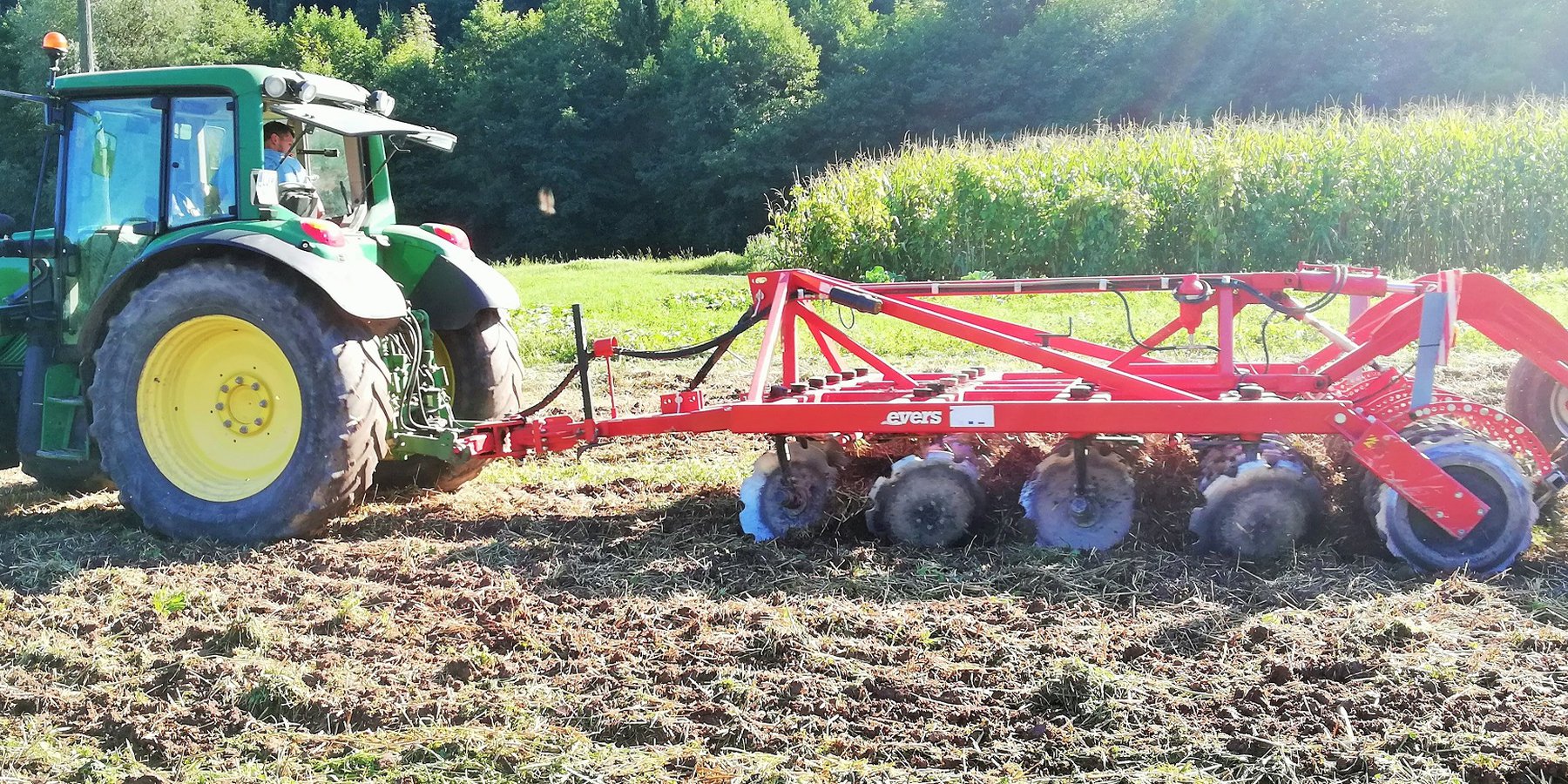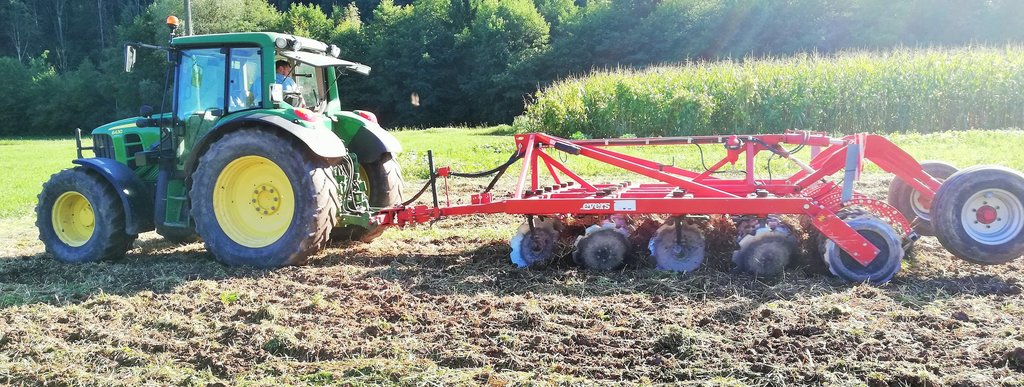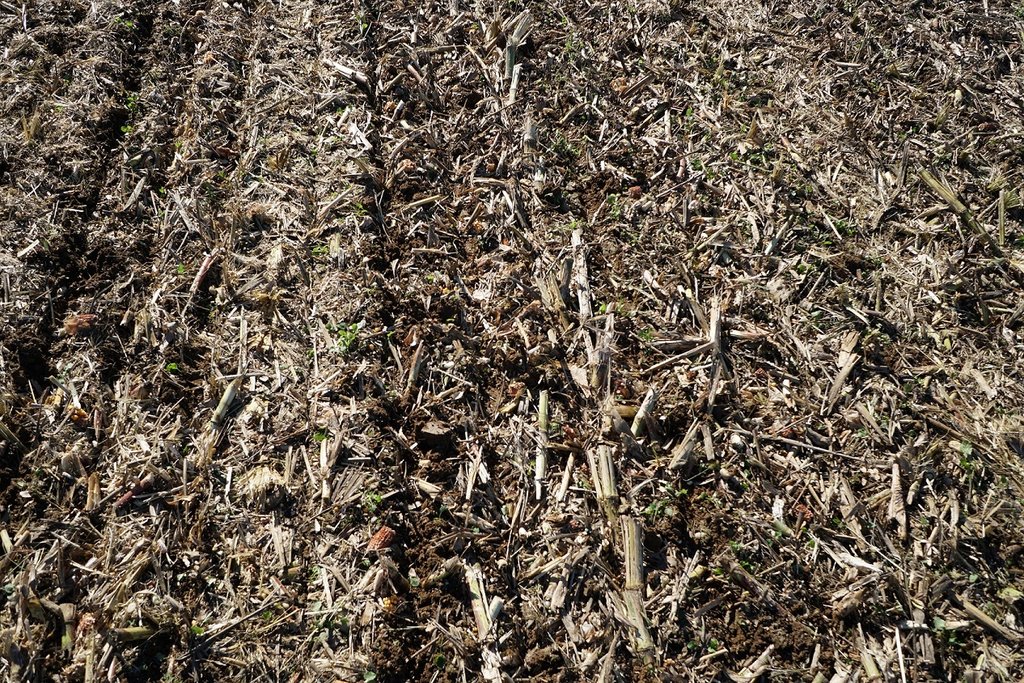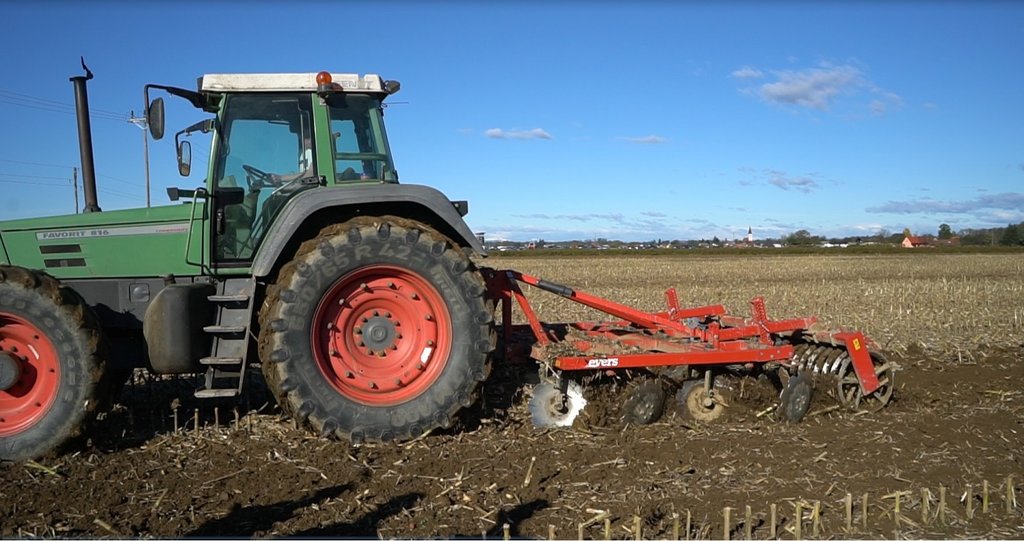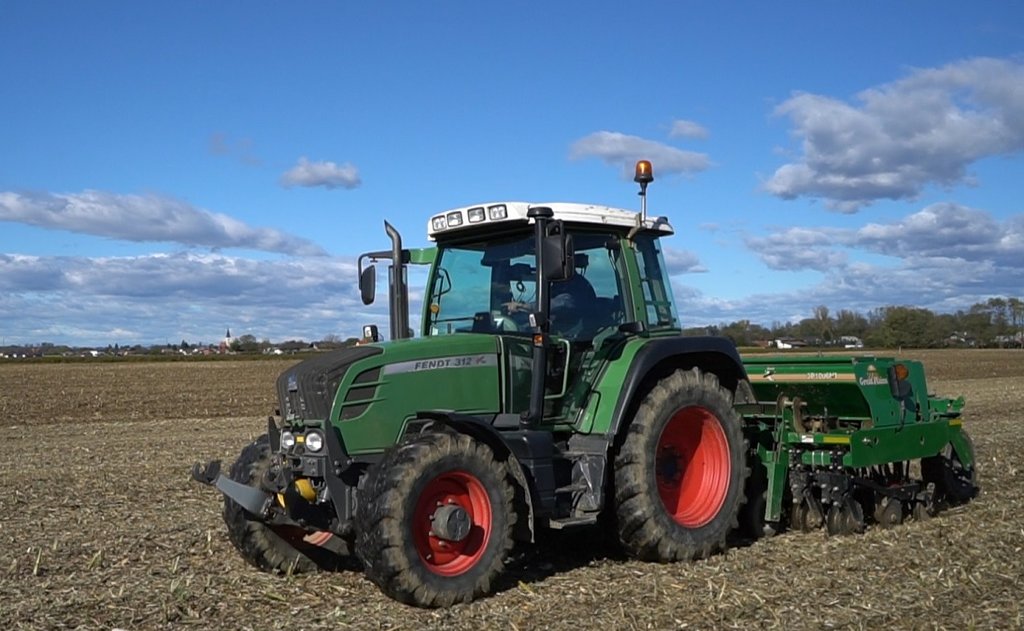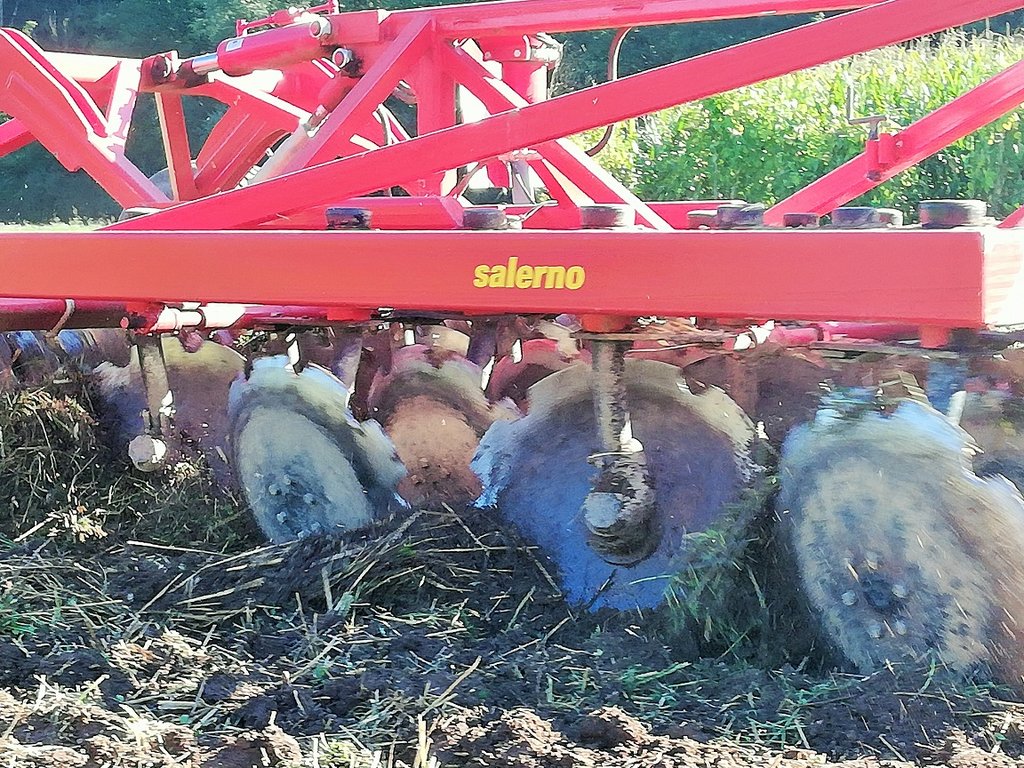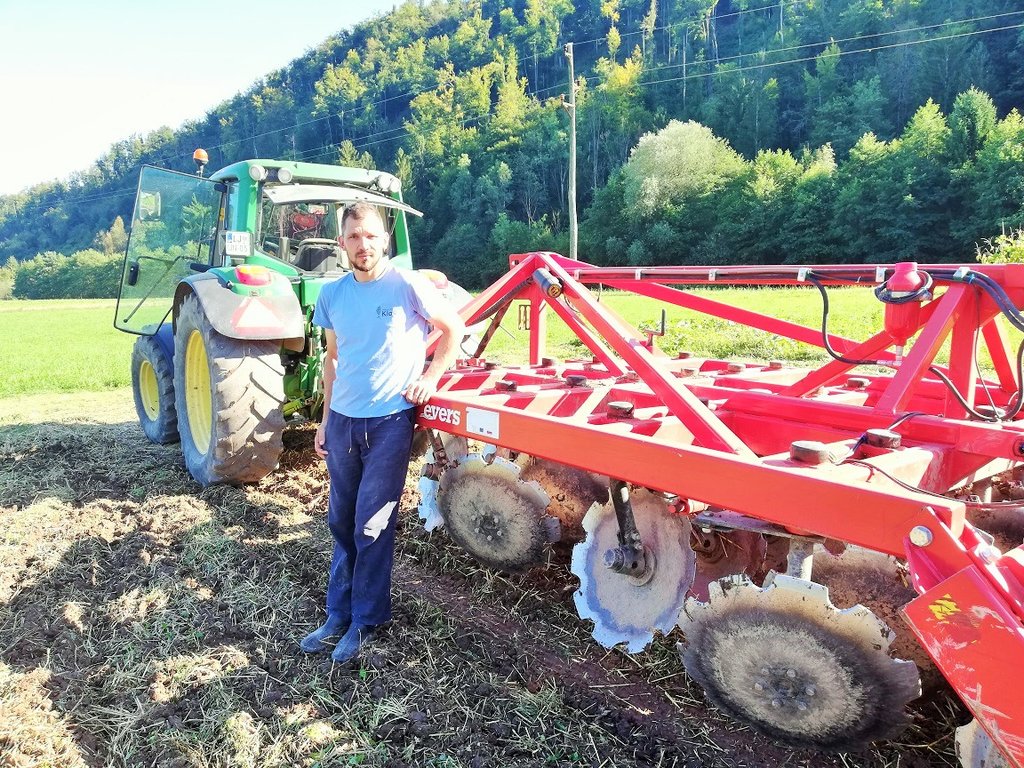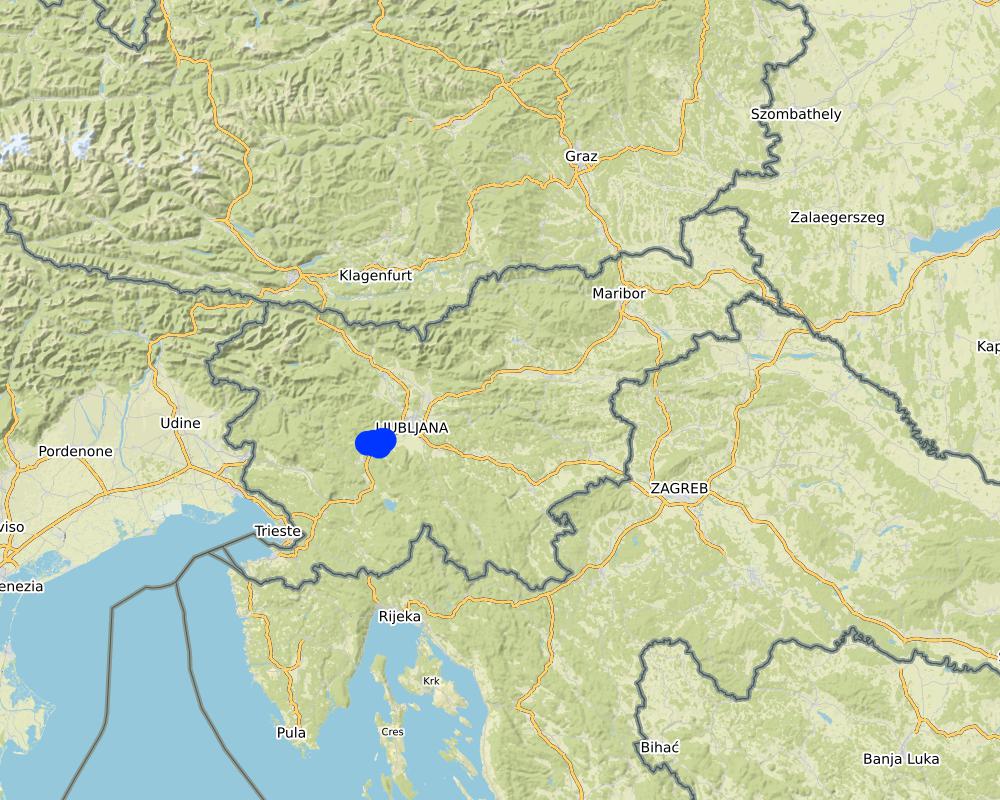Conservation tillage with incorporated mulched plant residues (mulch-till) [Eslovênia]
- Criação:
- Atualização:
- Compilador/a: Matjaz Glavan
- Editor: –
- Revisor: Rima Mekdaschi Studer
Ohranitvena obdelava tal z vdelavo mulčenih rastlinskih ostankov
technologies_5494 - Eslovênia
Veja as seções
Expandir tudo Recolher tudo1. Informação geral
1.2 Detalhes do contato das pessoas capacitadas e instituições envolvidas na avaliação e documentação da tecnologia
Pessoa(s) capacitada(s)
usuário de terra:
Mrzlikar Anton
Family farm
Eslovênia
Nome do projeto que facilitou a documentação/avaliação da Tecnologia (se relevante)
Interactive Soil Quality assessment in Europe and China for Agricultural productivity and Environmental Resilience (EU-iSQAPER)Nome da(s) instituição(ões) que facilitou(ram) a documentação/ avaliação da Tecnologia (se relevante)
Department for Agronomy, University of Ljubljana - Eslovênia1.3 Condições em relação ao uso da informação documentada através de WOCAT
O compilador e a(s) pessoa(s) capacitada(s) aceitam as condições relativas ao uso de dados documentados através do WOCAT:
Sim
1.4 Declaração de sustentabilidade da tecnologia descrita
A tecnologia descrita aqui é problemática em relação a degradação da terra de forma que não pode ser declarada uma tecnologia de gestão sustentável de terra?
Não
2. Descrição da tecnologia de GST
2.1 Descrição curta da tecnologia
Definição da tecnologia:
Conservation tillage with incorporated mulched plant residues (mulch-till) of harvested crop or a green manure that are part of the rotation). Crop residues are partially incorporated/mixed in topsoil layer (down to 10 cm) using a disc harrow, chisel plough, sweeps, field cultivators, that leave more than 30% of the soil surface covered with crop residue. Technology contributes to less soil disturbance, increase of soil organic matter, better soil structure and better water holding capacity of soils.
2.2 Descrição detalhada da tecnologia
Descrição:
1. The technology of conservational tillage with incorporated mulched plant residues (mulch-till) is applied in flatlands around the Municipality of Vrhnika with an average altitude of 290 m.a.s.l. Average annual precipitation is 1400 mm. The area is characterized with often stormy precipitation events and occasional summer droughts. A farmer applies this technology on various soil types from silty loam to silty clay Gleysol to organic Histosol soils (peat). Soils in the area are generally moderately deep to deep with medium soil organic matter (Gleysol) of 3-7% or with a high share of organic matter (Histosol) of >20% (Ljubljana moors). The area has good availability of surface water and groundwater of good drinking quality. Gleysol areas are drained (drainage systems) to prevent floods to enable cultivation. Histosol areas are drained (open-channel drainage systems) to enable arable crop production. However, due to high groundwater and many surface water sources, certain areas are regularly flooded during flood events mostly in late autumn, winter and spring. Salinity is not a problem due to high precipitation and leaching. Farmer practices rotational agriculture. Less than 5% of income coming from off-farm activities. The examined farm household has an average wealth and is fully mechanized/motorized. the farm has good access to services and infrastructure. The examined farm is medium in scale with land partly owned by the land user and partly leased from other private owners.The general biodiversity of the area is medium on Gleysols to high on Histosol where nature protection Landscape Park of Ljubljansko Barje (The Ljubljana Moors Landscape Park) is located.
Part of the farmers land parcels is located inside boundaries of Krajinski park Ljubljansko barje /Ljubljana Moor Landscape park. Park takes a lot of actions to secure peat soils. This almost 16,000 hectares large lowland marshy plain is marked by an interminable mosaic of grasslands, broadleaf woodlands, fields, ditches and hedges.
The farmer decided to abandon conventional ploughing technology and to start with conservational tillage technology when he noticed that the organic layer of peat soils in these areas started to become thinner. Farmer introduced this technology to preserve peat soils of Ljubljana Moors on his parcels in 2015. With ploughing, peat was mixed and decomposing - mineralise. In 18th-century peat layers of up to 2m depth were exploited for the same use as firewood. Only shallow layers of peat soil (up to 1 m) are still covering agricultural areas. As peat is a source of fertility farmers are seeking ways of preserving it. Farmer Anton Mrzlikar took a lead and started with conservational tillage with incorporated mulched plant residues (mulch-till).
Video https://vimeo.com/97415985 presents the effects of conservational tillage with incorporated mulched plant residues (mulch-till) on soil stability. This is a simulation of abundant summer rain and its impact on the tilled soils in terms of water infiltration capacity and erodibility. The result of this simulation is presented very clearly. It shows the difference between long-term conventional versus conservation tillage (mulch-till). Conventional tillage ploughs the top 25-28 cm of the soil at least once or twice a year. The soil is inverted, its structure breaks down and the surface is left bare. The first raindrops break the structural aggregates causing soil surface siltation and blockage of the soil pores. Thus vertical water flow is blocked and redirected as surface runoff, causing distinct erosion. If fertilizers and pesticides are used, the water flow will transport them, along with the soil particles, to surface waters where they cause pollution or surface ponding on the fields. This leads to an uneven distribution of substances across the field surface.
In conservation tillage (mulch-till), a shallow, 10 cm layer of topsoil is mixed with organic residues which are thus retained near and on the surface. In this way, soil structure is reinforced with good soil water infiltration and absorption. Despite heavy rainfall, the soils do not show any signs of erosion. There is no surface flow. Water drains into the soil vertical flow where it is available to the plants.
2. The farmer usees of 4-row-disk harrow tillage machinery (vario-disc) on arable fields for all crop types. When cultivating fields he crosses fields 1 - 2 times (depends on soil moisture). Every few years he uses chisels to break and shatters (aerate) the soils (depends on crop type - cereals and drought years). After main/first crop he seeds various cover crops (if fodder is needed they harvested it otherwise is used for green manure). He uses manure 30-40 t/ha. He applies typical dairy cow farm rotation (cereals/maize/soya/grass-clover mix). Cover crops are classified as rapes, cereals, oats, grass-clover, grass.
3. The main function is an increase of organic matter, retain water, increase soil biodiversity, stabilise soil structure in the soils and reduce water erosion, as well as reduce energy consumption and costs. This leads to better (1) productivity due to nutrients slow-release, (2) better water holding capacity and (3) decreased soil compaction threat. The technology was introduced to prevent decomposition of organic matter on Ljubljana moor peat soils.
4. Major inputs needed to establish is to change machinery and to gain new knowledge and experiences. They had to buy 4-row disc harrows, chisels plough and new seeders (maize). Seeding machines for cereals and oilseed rape are hired from other farmers. It is important that soils are covered all year round. Soils must be dry when cultivated.
5. The benefits are (1) increase in soil organic matter, (2) increase soil water holding capacity, (3) to maintain soil productivity, (4) increase in yields quantity and quality, (5) reduce energy consumption, (6) reduce workload - 3-4 times less time used for cultivation, (7) reduce costs.
6. Land users like (1) reduced workload and energy consumption, (2) positive impact on soil fertility and stability, (3) preserves organic matter - decrease peat soils decomposition, (4) as soils need to be covered all the time they produce more feed for cows, (5) smooths surface fields, (6) with disc harrow is easy to till soils even when residues are present on fields, (7) less soil compaction
Land users dislike: (1) investment cost for new machinery are high, (2) time to change in doing things and practice, (3) on clay soils (Gleysol) surface ponding is occurring, (4) soils need to be drier for tilling in comparison to ploughing.
2.3 Fotos da tecnologia
2.4 Vídeos da tecnologia
Comentários, breve descrição:
This is a simulation of abundant summer rain and its impact on the tilled soils in terms of water infiltration capacity and erodibility. The result of this simulation is presented very clearly. It shows the difference between long-term conventional versus conservation soil tillage.
Conventional tillage ploughs the top 25-28 cm of the soil at least once or twice a year. The soil is inverted, its structure breaks down and the surface is left bare. The first raindrops break the structural aggregates causing soil surface siltation and blockage of the soil pores. Thus vertical water flow is blocked and redirected as surface runoff, causing distinct erosion. If fertilizers and pesticides are used, the water flow will transport them, along with the soil particles, to surface waters where they cause pollution or surface ponding on the fields. This leads to an uneven distribution of substances across the field surface.
In conservation tillage (mulch-till), a shallow, 10 cm layer of topsoil is mixed with organic residues which are thus retained near and on the surface. In this way, soil structure is reinforced with good soil water infiltration and absorption. Despite heavy rainfall, the soils do not show any signs of erosion. There is no surface flow. Water drains into the soil vertical flow where it is available to the plants.
Data:
04/12/2017
Localização:
Ljubljana, Biotechnical Faculty, University of LJubljana
Nome do cinegrafista:
Rok Mihelič, Marko Zupan, Matjaž Glavan - Agronomy Department, Biotechnical Faculty, University of Ljubljana
Comentários, breve descrição:
Presenting 4-row disch harrow in action.
Data:
12/04/2017
Localização:
Slovenia
Nome do cinegrafista:
Rok Mihelič, Agronomy Department, Biotechnical Faculty, University of Ljubljana
Comentários, breve descrição:
Presening seeder (cereals/oilseed rape) in action and condition of soil surface after tillage and seeding.
Data:
12/04/2017
Localização:
Slovenia
Nome do cinegrafista:
Rok Mihelič, Agronomy Department, Biotechnical Faculty, University of Ljubljana
2.5 País/região/locais onde a tecnologia foi aplicada e que estão cobertos nesta avaliação
País:
Eslovênia
Região/Estado/Província:
Central Slovenia
Especificação adicional de localização:
Podlipa, Vrhnika. This specific farmer applies this technology on Ljubljansko barje, othewise is applied all over Slovenia
Especifique a difusão da tecnologia:
- Aplicado em pontos específicos/concentrado numa pequena área
O(s) local(is) tecnológico(s) está(ão) localizado(s) em uma área permanentemente protegida?
Sim
Caso afirmativo, especifique:
Part of his land parcels is located inside boundaries of Krajinski park Ljubljansko barje /Ljubljana Moor Landscape park. Park takes a lot of actions to secure peat soils. This almost 16,000 hectares large marshy plain is marked by an interminable mosaic of grasslands, broadleaf woodlands, fields, ditches and hedges.
http://www.ljubljanskobarje.si/?lang=en
Map
×2.6 Data da implementação
Indique o ano de implementação:
2015
Caso o ano exato seja desconhecido, indique a data aproximada:
- menos de 10 anos atrás (recentemente)
2.7 Introdução da tecnologia
Especifique como a tecnologia foi introduzida:
- atráves de inovação dos usuários da terra
Comentários (tipos de projeto, etc.):
Farmer introduced this technology to preserve peat soils of Ljubljana Moors on his parcels in 2015. With ploughing, peat was mixed and decomposing - mineralise. In 18th-century peat layers of up to 2m depth were exploited for the same use as firewood. Only shallow layers of peat soil (up to 1 m) are still covering agricultural areas. As peat is a source of fertility farmers are seeking ways of preserving it. Farmer Anton Mrzlikar took a lead and started with mulch-till.
3. Classificação da tecnologia de GST
3.1 Principal/principais finalidade(s) da tecnologia
- Reduz, previne, recupera a degradação do solo
- Adaptar a mudanças climáticas/extremos e seus impactos
- Criar impacto econômico benéfico
3.2 Tipo(s) atualizado(s) de uso da terra onde a tecnologia foi aplicada
Uso do solo misturado dentro da mesma unidade de terra:
Não

Terra de cultivo
- Cultura anual
Cultivo anual - Especificar culturas:
- cereais - milho
- cereals - maize - legumes - grass-clover mix
Sistema de cultivo anual:
Milho ou rotação similar com feno/pasto
Número de estações de cultivo por ano:
- 1
O cultivo entre culturas é praticado?
Não
O rodízio de culturas é praticado?
Sim
Caso afirmativo, especifique:
cereals/maize/soy/grass-clover mix, additionally cover crops after main crop (soil must be covered all year round
3.3 O uso do solo mudou devido à implementação da Tecnologia?
O uso do solo mudou devido à implementação da Tecnologia?
- Não (Continuar com a pergunta 3.4)
3.4 Abastecimento de água
Abastecimento de água para a terra na qual a tecnologia é aplicada:
- Precipitação natural
3.5 Grupo de GST ao qual pertence a tecnologia
- Perturbação mínima ao solo
3.6 Medidas de GST contendo a tecnologia

Medidas agronômicas
- A2: Matéria orgânica/fertilidade do solo
- A3: Tratamento da superfície do solo
A3: Diferenciar os sistemas de lavoura:
A 3.2: Reduced tillage (> 30% soil cover)
3.7 Principais tipos de degradação da terra abordados pela tecnologia

Erosão do solo pela água
- Wt: Perda do solo superficial/erosão de superfície

Deteriorização física do solo
- Pc: Compactação
- Ps: Subsidência de solos orgânico, sedimentação do solo
3.8 Redução, prevenção ou recuperação da degradação do solo
Especifique o objetivo da tecnologia em relação a degradação da terra:
- Reduzir a degradação do solo
Comentários:
It is impossible to prevent degradation in the form of peat soil mineralisation in agricultural soils.
4. Especificações técnicas, implementação de atividades, entradas e custos
4.1 Desenho técnico da tecnologia
4.2 Informação geral em relação ao cálculo de entradas e custos
Especifique como custos e entradas foram calculados:
- por área de tecnologia
Indique o tamanho e a unidade de área:
30 ha
Outro/moeda nacional (especifique):
EUR
Se for relevante, indique a taxa de câmbio do USD para moeda local (por exemplo, 1 USD = 79,9 Real): 1 USD =:
0,9
Indique a média salarial da mão-de-obra contratada por dia:
50 EUR
4.3 Atividades de implantação
| Atividade | Periodicidade (estação do ano) | |
|---|---|---|
| 1. | Preparation of fields: Leveling depressions, reconstruction of drainage channels, using chisels to loose, break and aerate soil in deeper layers | two year before implemenation, dry soil. |
| 2. | Purchase of 4-row disc harrow | 1st year |
| 3. | Purchase of seeder for maize | 1st year |
| 4. | Purchase of seeder for cover crops | 1st year |
| 5. | Hire seeder for cereals (wheat, barley) | 1st year |
| 6. | Home made chisel plow for loosening the soil | 2nd year |
| 7. | Purchase of spraying machine | 3rd year |
| 8. | Purchase of GPS navigation system | 3rd year |
Comentários:
The agricultural technology activities are listed in chronological order. Rotation cycle takes 3 years
4.4 Custos e entradas necessárias para a implantação
| Especifique a entrada | Unidade | Quantidade | Custos por unidade | Custos totais por entrada | % dos custos arcados pelos usuários da terra | |
|---|---|---|---|---|---|---|
| Equipamento | chisel plow material (home made) | EUR/piece | 1,0 | 6500,0 | 6500,0 | 100,0 |
| Equipamento | seeder fo cover crops | EUR/piece | 1,0 | 2500,0 | 2500,0 | 50,0 |
| Equipamento | seeder for maize | EUR/piece | 1,0 | 7500,0 | 7500,0 | 50,0 |
| Equipamento | 4-row disk harrow | EUR/piece | 1,0 | 23000,0 | 23000,0 | 50,0 |
| Equipamento | sprayer | EUR/piece | 1,0 | 12,5 | 12,5 | 25,0 |
| Equipamento | GPS navigation | EUR/piece | 1,0 | 2500,0 | 2500,0 | 100,0 |
| Equipamento | hire seeder for cereals | EUR/ha | 15,0 | 50,0 | 750,0 | 100,0 |
| Custos totais para a implantação da tecnologia | 42762,5 | |||||
| Custos totais para o estabelecimento da Tecnologia em USD | 47513,89 | |||||
Se o usuário da terra arca com menos que 100% dos custos, indique quem cobre os custos remanescentes:
50% - Agency for agricultural payments (EU funds); 25% - sharred among farmers
Comentários:
Cost for hiring seeder is calculated for 15ha as cereals cover 15ha of arable land.
4.5 Atividades recorrentes/manutenção
| Atividade | Periodicidade/frequência | |
|---|---|---|
| 1. | Maintenance of 4-disc harrow | 6 time per year, before or after use of equipment |
| 2. | Maintenance of Spayer | before use nozzels check, after use cleaning |
| 3. | Maintenance of seeder for maize | before and after use |
| 4. | Maintenance of seeder for cover crops | before and after use |
4.6 Custos e entradas necessárias pata a manutenção/atividades recorrentes (por ano)
| Especifique a entrada | Unidade | Quantidade | Custos por unidade | Custos totais por entrada | % dos custos arcados pelos usuários da terra | |
|---|---|---|---|---|---|---|
| Mão-de-obra | Maintenance of 4-disc harrow | hour | 6,0 | 6,25 | 37,5 | 100,0 |
| Mão-de-obra | Maintenance of Spayer | hour | 6,0 | 6,25 | 37,5 | 100,0 |
| Mão-de-obra | Maintenance of seeder for maize | hour | 4,0 | 6,25 | 25,0 | 100,0 |
| Mão-de-obra | Maintenance of seeder for cover crops | hour | 1,0 | 6,25 | 6,25 | 100,0 |
| Equipamento | Lubricant cartridge for4-disc harrow | cartridge | 18,0 | 5,0 | 90,0 | 100,0 |
| Equipamento | Nozzels for Spayer | nozzel | 20,0 | 4,0 | 80,0 | 100,0 |
| Equipamento | Lubricant cartridge for seeder for maize | cartridge | 4,0 | 5,0 | 20,0 | 100,0 |
| Equipamento | Lubricant cartridge for seeder for cover crops | cartridge | 1,0 | 5,0 | 5,0 | 100,0 |
| Custos totais para a manutenção da tecnologia | 301,25 | |||||
| Custos totais de manutenção da Tecnologia em USD | 334,72 | |||||
Comentários:
There is a big difference between conventional and conservation tillage in time spend cultivating fields.
Farmer estimates reduction in workload (no ploughing) for 3-4 times in comparison to the conventional ploughing system.
Farmer points out an increase in green mass yield (clover, grass) due to cover crops which can be used as feed for livestock or green manure. He said that the most important part of this conservational system (mulch-till) is to prevent weeds to germinate, and that's why soil needs to be covered at all times.
He also states that top and subsoil layers are loose.
He states that he still uses the same amount of plant protection products.
The use of herbicides and fertilisers is at the same range as before the shift in practice, but he expects improvements in the future when he will further enhance knowledge on crop types, rotation and cover crops.
4.7 Fatores mais importantes que afetam os custos
Descreva os fatores mais determinantes que afetam os custos:
The starting cost - The type of machinery is needed that has to be robust and heavy to much-till and seed into the soil.
The machinery must be in use to return a profit. Working hours are reduced now (no ploughing). Machine operators with more competences can reduce costs.
5. Ambiente natural e humano
5.1 Clima
Precipitação pluviométrica anual
- <250 mm
- 251-500 mm
- 501-750 mm
- 751-1.000 mm
- 1.001-1.500 mm
- 1.501-2.000 mm
- 2.001-3.000 mm
- 3.001-4.000 mm
- > 4.000 mm
Zona agroclimática
- úmido
Heavy summer thunderstorms and showers. Local precipitation.
5.2 Topografia
Declividade média:
- Plano (0-2%)
- Suave ondulado (3-5%)
- Ondulado (6-10%)
- Moderadamente ondulado (11-15%)
- Forte ondulado (16-30%)
- Montanhoso (31-60%)
- Escarpado (>60%)
Formas de relevo:
- Planalto/planície
- Cumes
- Encosta de serra
- Encosta de morro
- Sopés
- Fundos de vale
Zona de altitude:
- 0-100 m s.n.m.
- 101-500 m s.n.m.
- 501-1.000 m s.n.m.
- 1.001-1.500 m s.n.m.
- 1.501-2.000 m s.n.m.
- 2.001-2.500 m s.n.m.
- 2.501-3.000 m s.n.m.
- 3.001-4.000 m s.n.m.
- > 4.000 m s.n.m.
Indique se a tecnologia é aplicada especificamente em:
- Não relevante
5.3 Solos
Profundidade do solo em média:
- Muito raso (0-20 cm)
- Raso (21-50 cm)
- Moderadamente profundo (51-80 cm)
- Profundo (81-120 cm)
- Muito profundo (>120 cm)
Textura do solo (solo superficial):
- Fino/pesado (argila)
Textura do solo (>20 cm abaixo da superfície):
- Fino/pesado (argila)
Matéria orgânica do solo superficial:
- Alto (>3%)
Caso disponível anexe a descrição completa do solo ou especifique as informações disponíveis, p. ex. tipo de solo, PH/acidez do solo, nitrogênio, capacidade de troca catiônica, salinidade, etc.
Organic matter on Gleysol is around 6% and on Histosol (peatland) more than 30%. Bellow the peatland is clay (called "polžarica", or "snail clay")
5.4 Disponibilidade e qualidade de água
Lençol freático:
< 5 m
Disponibilidade de água de superfície:
Bom
Qualidade da água (não tratada):
apenas para uso agrícola (irrigação)
A qualidade da água refere-se a:
água de superfície
A salinidade da água é um problema?
Não
Ocorre inundação da área?
Sim
Regularidade:
Esporadicamente
Comentários e outras especificações sobre a qualidade e a quantidade da água:
On Ljubljana moor, seasonal floods are occurring regularly due to the high water table.
5.5 Biodiversidade
Diversidade de espécies:
- Alto
Diversidade de habitat:
- Alto
Comentários e outras especificações sobre biodiversidade:
This true especially for the Ljubljana moor.
5.6 Características dos usuários da terra que utilizam a tecnologia
Sedentário ou nômade:
- Sedentário
Orientação de mercado do sistema de produção:
- Comercial/mercado
Rendimento não agrícola:
- Menos de 10% de toda renda
Nível relativo de riqueza:
- Média
Indivíduos ou grupos:
- Indivíduo/unidade familiar
Nível de mecanização:
- Mecanizado/motorizado
Gênero:
- Mulheres
- Homens
Idade dos usuários da terra:
- Crianças
- meia-idade
- idosos
5.7 Área média de terrenos utilizados pelos usuários de terrenos que aplicam a Tecnologia
- < 0,5 ha
- 0,5-1 ha
- 1-2 ha
- 2-5 ha
- 5-15 ha
- 15-50 ha
- 50-100 ha
- 100-500 ha
- 500-1.000 ha
- 1.000-10.000 ha
- > 10.000 ha
É considerado pequena, média ou grande escala (referente ao contexto local)?
- Média escala
Comentários:
83 ha of agricultural land and 7 ha of forest
5.8 Propriedade de terra, direitos de uso da terra e de uso da água
Propriedade da terra:
- Indivíduo, intitulado
Direitos do uso da terra:
- Arrendado
- Indivíduo
Direitos do uso da água:
- Indivíduo
Os direitos de uso da terra são baseados em um sistema jurídico tradicional?
Sim
Comentários:
2/3 of land is hired from The Farmland and Forest Fund of the Republic of Slovenia
5.9 Acesso a serviços e infraestrutura
Saúde:
- Pobre
- Moderado
- Bom
Educação:
- Pobre
- Moderado
- Bom
Assistência técnica:
- Pobre
- Moderado
- Bom
Emprego (p. ex. não agrícola):
- Pobre
- Moderado
- Bom
Mercados:
- Pobre
- Moderado
- Bom
Energia:
- Pobre
- Moderado
- Bom
Vias e transporte:
- Pobre
- Moderado
- Bom
Água potável e saneamento:
- Pobre
- Moderado
- Bom
Serviços financeiros:
- Pobre
- Moderado
- Bom
6. Impactos e declarações finais
6.1 Impactos no local mostrados pela tecnologia
Impactos socioeconômicos
Produção
Produção agrícola
Qualidade da safra
Produção de forragens
Comentários/especificar:
It increased due to the fact that soil has to be covered at all times (grass, clover, cover crops) to retain soil moisture and prevent soil erosion and to provide an optimal living condition for soil life (fauna, flora). Previously the land was left bare after harvesting cereals until autumn or even spring.
Qualidade da forragem
Produção animal
Comentários/especificar:
Due to more fodder, the farmer managed to increase the number of livestock (dairy cows).
Risco de falha de produção
Comentários/especificar:
Due to the fact that soils are not ploughed anymore, a farmer has in wet years (more precipitation in a short period of time, especially in the springtime) problems on organic marshland and clay gley soils being fully saturated. This causes a reduction in the germination of seeds and weaker growth of plants due to hypoxia.
Diversidade de produtos
Comentários/especificar:
More different types of cover crops in production. Some are used as nitrogen fixators or for loosening the soils with deep rots.
Gestão de terra
Comentários/especificar:
The land management simplified due to fewer machines needed and less time need for land cultivation and soil preparation.
Renda e custos
Despesas com insumos agrícolas
Comentários/especificar:
Less petrol nedeed for land cultivation.
Rendimento agrícola
Comentários/especificar:
More livestock means more income.
Carga de trabalho
Comentários/especificar:
Workload decreased due to abandoning of ploughing.
Impactos socioculturais
Conhecimento de GST/ degradação da terra
Comentários/especificar:
The farmer observed positive impacts and seeks for more knowledge on this topic to improve its practice.
Impactos ecológicos
Ciclo hídrico/escoamento
Escoamento superficial
Evaporação
Solo
Umidade do solo
Cobertura do solo
Perda de solo
Ressecamento/ selagem do solo
Compactação do solo
Ciclo e recarga de nutrientes
Matéria orgânica do solo/carbono abaixo do solo
Biodiversidade: vegetação, animais
Cobertura vegetal
Biomassa/carbono acima do solo
Clima e redução de riscos de desastre
Impactos da seca
Emissão de carbono e gases de efeito estufa
Comentários/especificar:
Difficult to quantify. An increase in soil organic matter has an impact on CO2 sequestration.
6.3 Exposição e sensibilidade da tecnologia às mudanças climáticas graduais e extremos/desastres relacionados ao clima (conforme o ponto de vista dos usuários da terra)
Mudança climática gradual
Mudança climática gradual
| Estação do ano | aumento ou diminuição | Como a tecnologia lida com isso? | |
|---|---|---|---|
| Temperatura anual | aumento | bem | |
| Temperatura sazonal | verão | aumento | bem |
| Precipitação pluviométrica anual | bem | ||
| Precipitação pluviométrica sazonal | primavera | aumento | moderadamente |
Extremos (desastres) relacionados ao clima
Desastres climatológicos
| Como a tecnologia lida com isso? | |
|---|---|
| Onde de calor | bem |
| Seca | bem |
6.4 Análise do custo-benefício
Como os benefícios se comparam aos custos de implantação (do ponto de vista dos usuários da terra)?
Retornos a curto prazo:
levemente negativo
Retornos a longo prazo:
positivo
Como os benefícios se comparam aos custos recorrentes/de manutenção(do ponto de vista dos usuários da terra)?
Retornos a curto prazo:
levemente positivo
Retornos a longo prazo:
positivo
Comentários:
Benefits are on short term slightly negative due to investment costs, but in the long term they are positive - they pay off.
Maintenance benefits are positive for short as well as on long-term returns as less machinery and less land management activities is needed.
6.5 Adoção da tecnologia
- casos isolados/experimental
Se disponível, determine a quantidade (número de unidades familiares e/ou área abordada):
Only one farmer in the area that uses this technology. On the map you can observe his fields. In the last year many of his collegues observed advantages of this technology and hires his machinery as agriculture service of tillage. In majority of times before cover crops seeding.
6.6 Adaptação
A tecnologia foi recentemente modificada para adaptar-se as condições variáveis?
Não
6.7 Pontos fortes/vantagens/oportunidades da tecnologia
| Pontos fortes/vantagens/oportunidades na visão do usuário da terra |
|---|
| Reduction of workload (no ploughing, less time spent on the field) |
|
Change in farmers mindset is longlasting; they are forced to gain new knowledge on technology impact on soil condition With more knowledge and better handling of technology, the cost of maintenance and time spent in the field can reduce significantly. |
|
Increase in green mass yield (clover, grass) - it can be used as feed for livestock or green manure. Soil covered all year round + residues impact increase in soil organic matter, soil water content, biological activity, soil structure, less soil compaction. |
| Pontos fortes/vantagens/oportunidades na visão do compilador ou de outra pessoa capacitada |
|---|
| Cost and time reductions are substantial - 3-4 times less in comparsio to conventional - ploughing. |
|
Farmers became aware of the importance of conservation soil management and its impact on soil properties and finally on the process of production-chain (soil-feed-milk). With proper shaping of knowledge (advising, education) - Conservational tillage has the potential to develop into the direction of organic farming. |
| Soil structure and fertility improve |
6.8 Pontos fracos, desvantagens/riscos da tecnologia e formas de superá-los
| Pontos fracos/desvantagens/riscos na visão do usuário da terra | Como eles podem ser superados? |
|---|---|
| On heavy soils (Glaysoils) surface ponding can occur if the farmer is not experienced with using technology. | Observe weather regularly and follow meteorological forecasts. Try to avoid wet periods. |
| Weed may be a problem in the warmer part of the year, mainly after cereals are harvested. | They use herbicide and adapt or improve crop types in rotation. |
| Peatland on Ljubljana moor. There are small parcels and soil in springtime is wet prohibiting to cultivate at any time (high water table). | Observe weather regularly and follow meteorological forecasts. They have to observe soil water content conditions periodically at peatland parcels. |
| Pontos fracos/vantagens/riscos na visão do compilador ou de outra pessoa capacitada | Como eles podem ser superados? |
|---|---|
| Farmers still need to use herbicides as weeds are a problem especially in the early stage of crop growing (narrow-leaf) and in the last stage when crops go into senescence and light gets to the ground (broad-leaf). |
As this is a conventional type of farm, they use herbicides. However, with the promotion of organic agriculture, the expansion of vegetable production, and innovations in GPS and sensors technology hoeing/weeding machines/equipment is getting popular. This problem is even more problematic in light/alluvial soils. |
| Surface ponding on heavy soils is a problem in case of longlasting rain periods in spring, which are due to climate change more often in the described area. |
It is crucial to use chisel plow in this soils to break soil layers deeper and provide drainage potential of this soils. In light alluvial soils, this problem is not observed. |
| When a farmer in under Slovenian agricultural conditions decides to change from conventional to conservation tillage, it has to change all machinery. | Farmers need to get as much as possible information on technology. Farmers have to make a business plan. EU funds can help with subsidy payments for investments on the farm (approx. 50-60%). |
7. Referências e links
7.1 Métodos/fontes de informação
- visitas de campo, pesquisas de campo
1 farmer
- entrevistas com usuários de terras
1 farmer
- entrevistas com especialistas em GST
1 specialist
Quando os dados foram compilados (no campo)?
10/05/2019
7.3 Links para informações on-line relevantes
Título/ descrição:
OHRANITVENA OBDELAVA TAL –STANJE V SLOVENIJI
URL:
http://www.digitalna-knjiznica.bf.uni-lj.si/du1_ograjsek_simon.pdf
Título/ descrição:
Izzivi uvajanja konzervirajoče (ohranitvene) obdelave tal
URL:
http://www.kmetzav-mb.si/Lombergar_18/Lomb_5_2_18.pdf
Título/ descrição:
NOVE TEHNOLOGIJE IN SODOBNI TRENDI OBDELOVANJA TAL
URL:
http://www.kgzs-ms.si/wp-content/uploads/2018/04/STAJNKO_NOVE-TEHNOLOGIJE.pdf
Título/ descrição:
Ohranitvena obdelava : primerjava lastnosti mehansko obdelanih in neobdelanih prsti
URL:
https://www.dlib.si/details/URN:NBN:SI:DOC-LTCNTC4J
Título/ descrição:
SZOORT - Slovensko združenje za ohranitveno obdelavo in rodovitnost tal
URL:
http://www.szoort.si/
Título/ descrição:
Ohranitveni način obdelave tal
URL:
https://www.program-podezelja.si/sl/247-eup/izmenjevalnik-idej/seznam-izzivov/759-ohranitveni-obdelave-tal
Links e módulos
Expandir tudo Recolher tudoLinks
Não há links
Módulos
Não há módulos


